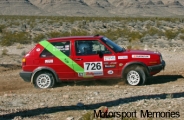The .9 ovalized ratio came from FIA rules.
As for door bar designs. I'll make one statement about the upper and lower shallow U's connected at the center; it solves the 'broken tube as a spear' issue, but presents a whole new issue. The center joint needs to be SUPER STRONG for this design. If you hit hard anywhere close to the central joint, as the tubes bend in, they will also want to rotate, as the points of support are not inline with the tube centerlines. This rotation will tend to want to 'roll' the tubes relative to each other, swing the upper one upwards and in, and the lower one downwards and in, and this will put a tremendous amount of tearing stress on the center joint. It should be plated with .120" steel plate on the INSIDE, along the full length of where the tubes meet, preferrably with the plate wrapped a bit over and under the top and bottom of the 2 tubes. In this way, the plate has to tear apart before the tubes can tear apart. The flimsy 1mm clamshell gussets have little or no chance in this case. The center area in the double-shallow U design should be like 5-6" long so there is ample length for a stong joint.
Since studying this design more, I have been favoring the simple sill bar and sloped single door bar. The X designs really don't add anything specail for side impact except extra tubing and more support points that can spread the load, but it presents some real issues in keeping the center joint together. The rationale that I think really brought the X side bar design into being is so that the forward upper part of the X can meet the A-pillar at the same place where the forward strut brace, if used, also meets the A pillar. It carries the load coming through the strut brace and takes it back to the floor area at the base of the main hoop. So that is not a safety thing. It also can carry frontal impact loads better to the whole back half of the car, and so that part can be a safety benefit.




